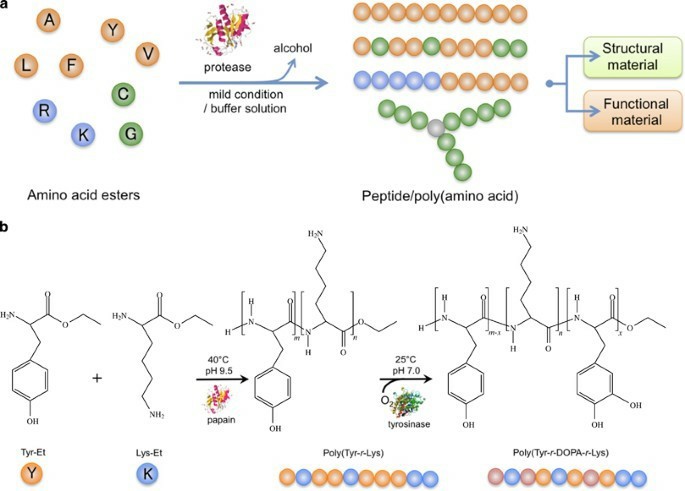Polyamino acids are compounds in which amino acid monomers are connected by amide bonds. Their chemical structures have high similarity and are widely used in the field of biomaterials. In view of the diversity of amino acids and tens of thousands of arrangements, people can construct a large number of Polypeptide molecules with specific amino acid sequences and corresponding biological activities. Polyamino acids are often considered to be a type of natural polypeptide or protein mimetic, which can be synthesized through the ring-opening polymerization of amino acid-N-carboxylic intracyclic anhydride. Compared with the relatively single self-assembly behavior of polypeptide molecules, polyamino acids are more diverse in terms of synthesis methods, self-assembly structures and conformational changes.
 Figure 1. Chemo-enzymatic synthesis of peptide/poly(amino acid)s.( Keiji Numata, et al.; 2015)
Figure 1. Chemo-enzymatic synthesis of peptide/poly(amino acid)s.( Keiji Numata, et al.; 2015)
In the past few decades, polyamino acid molecules have gradually become perfect building blocks of biomaterials due to their relatively simple synthesis methods, unique structural characteristics and inherent biological activities, and are widely used in the field of tumor treatment. The global market has now There are dozens of peptide drugs that have shown excellent therapeutic effects and broad application prospects in clinical practice. About 1/5 of them (such as Dolastatin 10, Degarelix, ATAP-M8 and IMM-101, etc.) are used in tumors treatment.
To further advance research into polyamino acids in drug delivery, CD Bioparticles offers polyamino acid products to help solve the following challenges.
The challenges you might meet:
- The drugs developed have greater side effects on the human body
- Drugs can easily cause the body's immune response and foreign body rejection
- Drugs have poor water solubility
- Inefficient distribution and transport of drugs in the body
- Drugs need to be released within specific tissues or cells
- Need to prolong the release time of drugs in the body
- Want to extend the shelf life of medicines
- Drug carrier systems need to be adapted to different types of drugs and therapeutic needs
Key polyamino acids features:
Key polyamino acids benefits:
- Polyamino acids usually have good biocompatibility and can reduce toxic and side effects on the human body.
- Since amino acids are natural building blocks of living organisms, the use of polyamino acids in drug delivery can reduce immune responses and foreign body rejection.
- Polyamino acids usually have good water solubility, which contributes to the water solubility of drugs and improves their bioavailability.
- Water-soluble polyamino acids facilitate the distribution and transport of drugs in the body.
- By adjusting the structure of polyamino acids, targeted release of drugs can be achieved.
- Polyamino acids can be designed to have a sustained-release effect, extending the release time of drugs in the body.
- Polyamino acids can improve the stability of drugs, protect them from the influence of the external environment, and extend the shelf life of drugs.
- Due to the diversity of amino acids, polyamino acids with multifunctional properties can be designed to adapt to different types of drugs and treatment needs by changing the types and arrangements of amino acids.
Application candidates:
- Polyamino acids can be designed for use in drug delivery systems to achieve slow or targeted release of drugs by changing their structure and chemical properties.
- Some polyamino acids are biodegradable, making them ideal for making absorbable medical devices and sutures.
- Polyamino acids can be used to create scaffolds and artificial tissues for tissue engineering and regenerative medicine.
- Polyamino acids can be used to make biosensors to detect biomolecules in living organisms.
- Polyamino acids can be used as vaccine carriers to improve immune responses.
- Polyamino acid nanoparticles can be designed for gene delivery to deliver genes into target cells.
- Polyamino acids can be used to prepare nanomaterials for biomedical imaging, such as magnetic resonance imaging (MRI) and optical imaging.
 Figure 1. Chemo-enzymatic synthesis of peptide/poly(amino acid)s.( Keiji Numata, et al.; 2015)
Figure 1. Chemo-enzymatic synthesis of peptide/poly(amino acid)s.( Keiji Numata, et al.; 2015)